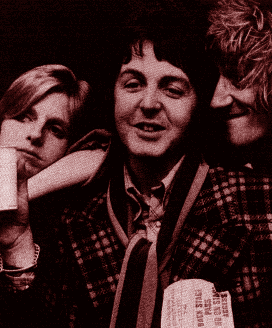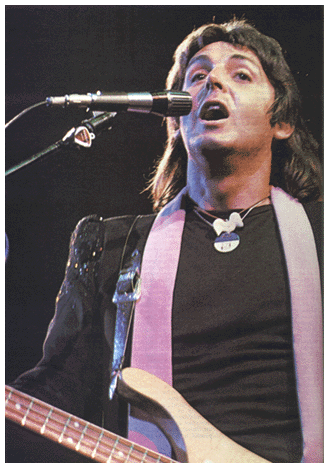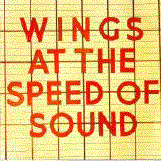|
That tune, "Helen Wheels," came from Band On the Run, Wings' most popular abum of the decade. It was recorded in an eight-track studio, built over a swamp, in Lagos, Nigeria. The album included "Jet" (named after the McCartneys' little black dog) and the title track, both of which became top pop singles in the States. Their final record of 1974 was cut in Nashville: "Sally G," backed with "Junior's Farm" ("Junior" was lead guitarist Jimmy McCullough). Both sides of that 45 also got a lot of air play.
In 1975, Wings switched labels from Apple to Capitol, and recorded Venus and Mars in L.A. and New Orleans. That album amassed orders of one-and-a-half million copies before release. Afterward, it yielded three major hits: "Listen to What the Man Said," "Letting Go," and "Rock Show." By 1976, Paul McCartney had certainly established himself as the consummate hitmaker -- composer, arranger, publisher, producer, bandleader, singer and musician. No one doubted his ability to make hits, but some criticized the sentimental way he sometimes did it. Even during his Beatle days, McCartney had been called a romantic, a softie, and he was never embarrassed by it. "I'm of fan of old-fashioned writing," he admitted. "I do like rhyme, when it comes off. I hate silly rhymes, but when they work, they're the greatest little things in songwriting." At the height of their contentiousness immediately following the breakup of the Beatles, John Lennon said that Paul's material was "a lot of rubbish," and that he "couldn't rock if he tried." "He sounds like Englebert Humperdinck," said Lennon, who further attacked his old partner in "How Do You Sleep?," a cut off the Imagine album. "I listened to him for a few years," said Paul, "and used to think, 'I can't write another of those soppy love songs. We've got to get hard and rocky now.' In the end, though, I realized that I just had to be myself. It's bolder, you know, to say, 'What's the difference? I like it.'" And with that, McCartney composed "Silly Love Songs" -- a tune that overcame its own silliness by its obvious sincerity. Its mass acceptance proved McCartney's point, much to his satisfaction. "The fact is, deep down, people are very sentimental," he said. "If they watch a sentimental movie at home, they cry, but in public they won't. We don't like to show our emotions; we tend to sneer at that. And in the same way, people may not admit to liking love songs, but that's what they seem to crave." Wings' single came out in mid-April 1976, just before the final leg of a tour that took them to the U.S., the U.K., Australia, and five cities in Europe (in Berlin, Paul and Linda painted the lyrics of "Silly Love Songs" on a bedsheet and paraded it along the Berlin Wall). In every town, the specter of Paul's former group was there -- in America, where a ten-year-old Beatle track, "Got to Get You Into My Life," had been revived; and in England, where almost a quarter of Britain's Top 100 single records were old Lennon-McCartney songs. In concert, post-Beatles material was emphasized, and the result was a rousing string of celebrative events. "Paul confronted his legacy," wrote one reviewer, "and was not engulfed by it." And of course, to make things sweeter, both Wings' new album (At the Speed of Sound) and single ("Silly Love Songs") reached number one while they were on the road.
The band was playing the Capitol Center in Washington, D.C. the day "Silly Love Songs" moved into the number one position on the Billboard Hot 100. Although it yielded to Diana Ross' "Love Hangover" for two weeks, "Silly Love Songs" returned to the top and stayed there an additional four weeks.
One high point on the tour for fans was the June 21 concert at the Forum in Inglewood, California. Near the end of the final number of the night, a man from the audience moved from his loge seat to the backstage area, and spontaneously grabbed a boquet of flowers and ran on stage. He handed the flowers to guitarist Denny Laine, kissed Linda on the hand and took McCartney's bass. The audience cheered as old friends Ringo Starr and Paul McCartney walked off the stage together. Of course, "Silly Love Songs" was performed every night. Time magazine called it "the sort of tune that comes at the unwary out of car radios and open windows, attaching itself like a particularly stubborn lap cat. It will probably never go away.... It is a sort of refined disco tune, made for dancing and casual listening." The song was written in reaction to the critics who said McCartney's music was lightweight. John Lennon, who accused his former collaborator of sounding like Engelbert Humperdinck, had attacked Paul's "muzak" five years earlier in the song, "How Do You Sleep?" But Paul, who ultimately had the most successful post-Beatles solo career, had no intention of changing his style. "I'm a fan of old-fashioned writing," he has admitted. "I do like rhyme, when it comes off. I hate silly rhymes, but when they work, they're the greatest little things in songwriting." Not that Paul needed the vindication, but "Silly Love Songs" was the number one single of 1976, according to Billboard. That made McCartney the only artist to be involved with three top singles of the year through 1988 -- also including the Beatles singles "I Want to Hold Your Hand" and "Hey Jude." - Fred Bronson, The Billboard Book of Number One Hits, Billboard, 1988.
No comments so far, be the first to comment. |



